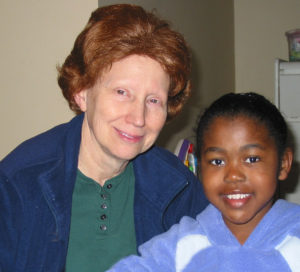The dedication and love Sister Margaret Ann has for the families and their children makes all the difference in Hope House’s success, Dupont said.
“She’s worth her weight in diamonds, not gold,” Dupont said.
Maria Randall is the director of social services at Hope House. She and Sister Margaret Ann have worked together since 2001.
Maria Randall has been director of social services at Hope House since 2001. One role is to oversee a play therapy room for children who’ve been exposed to trauma, such as the little boy who was in the car in which his father was murdered.
“This is a haven,” Randall said.
She and Sister Margaret Ann have worked well together since day one.
“She wears so many hats here,” Randall said. “She’s a master of all trades. She knows it inside and out.”
She credits their working relationship to a strong faith base, a commitment to ethical and honest treatment, and their ability to forgive. There’s also a part of their personalities that helps the relationship.
“She’s an introvert and I’m an extrovert,” Randall said with a smile.
Hapner said Sister Margaret Ann simply makes Hope House a better place.
“She strives to make sure everyone’s needs are met in and outside the classroom,” Hapner said. “She’s been there for me during difficult personal issues and professional issues. I’ve never been judged about anything in my private life.”
Some of the staff members aren’t coming from a much better situation than the families being served, and often live paycheck to paycheck, Hapner said.
Sister Margaret Ann said the teachers at Hope House have to set small goals for the children, because they don’t start out at the same level as other children. “No one is reading to them at home,” she said. Children have to be taught how to eat, speak, sit at a table and many other tasks that others take for granted.
Working with families who routinely come from tragic circumstances has changed Sister Margaret Ann’s outlook.
“It takes you out of yourself,” she said. “The first few years, I thought, ‘I can’t relate to these people. I grew up in the middle class. I can’t identify with people with no education, who don’t work and who live in the housing projects forever.’
“Slowly you start to treat them as people and some of them as peers, especially after I got Adasia,” she said. “Your stereotypes leave. They are struggling. They’ve been raped, abused, or had bad parents.”
Sister Margaret Ann officially became Adasia’s mother on May 22, 2006. Adasia turns 6 on May 4.
Adasia
Adasia’s entry into the world was something of a miracle. Her mother had full-blown AIDS and was an active crack cocaine user when she became pregnant with Adasia and when she gave birth. She was 37, but looked 75, Sister Margaret Ann said.
Two of Adasia’s siblings attended Hope House before her. “When I first saw Adasia, I said, ‘She’s a fighter,’” Sister Margaret Ann said. “The care-giving she got at Hope House saved her.”
St. Jude Children’s Hospital in Memphis has a pediatric AIDS program, and provides free drugs needed for the children’s survival. But there’s a protocol that must be followed when administering the drugs, and often the parents lack the discipline to give them on time, Sister Margaret Ann said.
Randall once visited Adasia’s home and almost sat on her because there was so much trash piled on the bed where Adasia slept, Sister Margaret Ann said.
Adasia turned 1 in May 2003, and in June, St. Jude had Adasia removed from the home, along with the other children, for their safety. Adasia’s mother died July 31.

